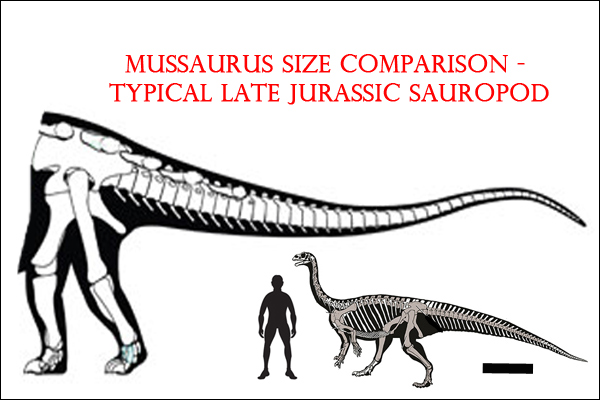New Research into Baby Dinosaurs
Mussaurus Switched from Four Legs to Two
A team of scientists, including researchers from the Royal Veterinary College based in London and Museo de La Plata and National Scientific and Technical Research Council (CONICET) located in Argentina, have collaborated to produce a report on how a Late Triassic sauropodomorph changed as it grew up.
The dinosaur in question Mussaurus patagonicus is an ideal candidate for dinosaur growth studies as it is known from numerous partial to nearly complete skeletons from hatchlings to fully grown adults. Writing in the academic journal the researchers conclude that Mussaurus could only move on four limbs once born but switched to two legs as it grew up, just as our species switches from all fours to bipedal walking as we grow.
Scientists Looked at How the Centre of Mass Changed in the Body of Mussaurus to Work Out How it Walked

Picture credit: Scientific Reports
An Argentinian Sauropodomorph
Fossils of Mussaurus come from southern Argentina, at birth this dinosaur was only a few centimetres in length, but it reached its adult size in around eight years. Essentially, this dinosaur went from weighing about 60 grams to weighing an estimated 1,300 kilograms with a body length of approximately 8 metres. The research team conclude that it might have barely been able to walk or run on two legs at the age of one, but would have only committed to being bipedal once it reached adulthood.
This study has implications for the largest terrestrial vertebrates that ever lived as Mussaurus is regarded as an ancestral form of the later sauropods, giants like Apatosaurus, Mamenchisaurus and Giraffatitan, that were to evolve in the Jurassic.
The team scanned key fossils of Mussaurus into three-dimensional models, connected the bones into digital skeletons, and added soft tissue to estimate the shape of the body and its major segments such as head, neck, torso, tail and limbs. These computer models were then used to estimate the location of the animal’s centre of mass, the point at which all weight can be assumed to act through. This estimate enabled the scientists to then test whether different models representing different growth stages of Mussaurus patagonicus could have stood on two legs or not, because the centre of mass must be placed under the feet in such poses.
Identifying the Centre of Mass as Mussaurus Grew Up

Picture credit: Scientific Reports
Baby Dinosaurs – From Four Legs to Two
One of the authors of the scientific paper, Dr Alejandro Otero (CONICET) stated:
“Mussaurus switched from four legs as a baby to two legs by adulthood, much as humans do. It is important to notice that such locomotor switching is rare in nature and the fact that we were able to recognise it in extinct forms like dinosaurs highlights the importance of our exciting findings.”
Professor John Hutchinson of the Royal Veterinary College, an expert in animal locomotion and co-author of the paper commented:
“We created the first 3-D representation of the major changes of body form and function across the growth of a dinosaur. And we were surprised to learn that enlargement of the tail and reduction of the neck had more of an effect on how Mussaurus stood than how long its forelimbs were, which is what people used to think.”
Implications for Giant Dinosaurs
At around eight metres in length, Mussaurus was one of the largest dinosaurs in southern South America during the Late Triassic (estimated to be Norian faunal stage), however, during the Jurassic and Cretaceous much larger lizard-hipped dinosaurs would evolve from this lineage. By improving our understanding about how some of the sauropodomorphs moved this type of research can provide insights into how much bigger plant-eating, long-necked giants walked. When adult, dinosaurs such as Diplodocus and Brachiosaurus were very much quadrupedal, although it has been suggested that when very young some of these dinosaurs might have been able to rear up onto their hind legs to escape danger.*
Mussaurus Scale Comparison

Picture credit: Scientific Reports with additional annotation and information from Everything Dinosaur
* To read an article from 2011 that looked at the research into trace fossils from the western United States that hinted that some very young sauropods may have been able to run on just their hind legs: Facultative Bipedalism in Sauropods.
The research team hope to build on this work as they plan to use computer models to replicate in greater detail how Mussaurus may have actually moved, such as how fast it could walk or run.
Everything Dinosaur acknowledges the assistance of a press release from the Royal Veterinary College (London) in the compilation of this article.
The scientific paper: “Ontogenetic changes in the body plan of the sauropodomorph dinosaur Mussaurus patagonicus reveal shifts of locomotor stance during growth” by Alejandro Otero, Andrew R. Cuff, Vivian Allen, Lauren Sumner-Rooney, Diego Pol and John R. Hutchinson published in Scientific Reports.
Visit the Everything Dinosaur website: Everything Dinosaur.

